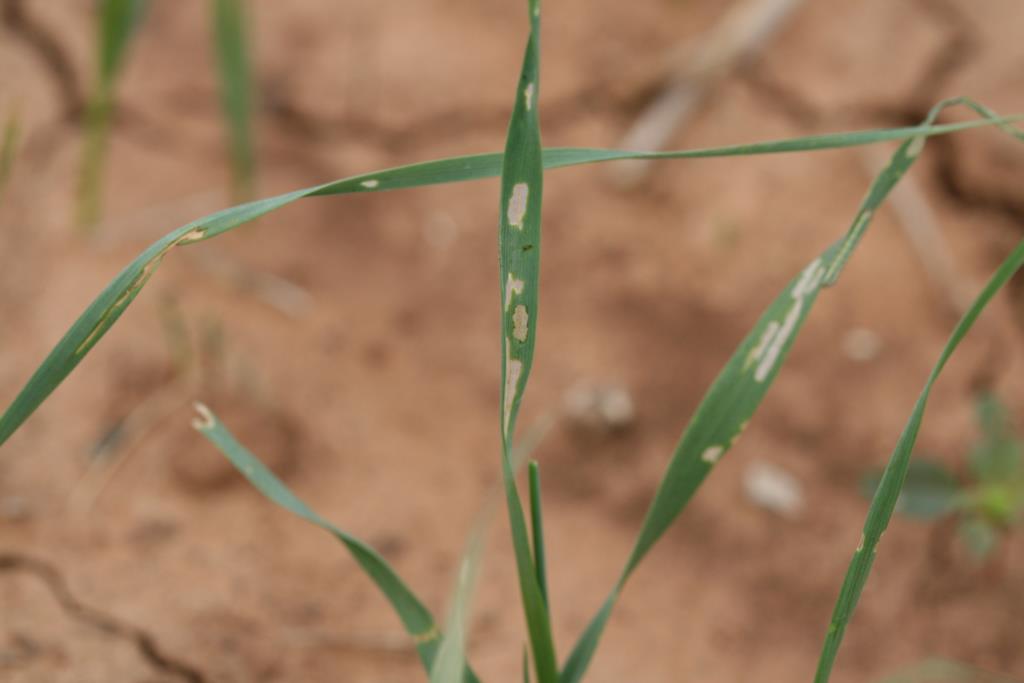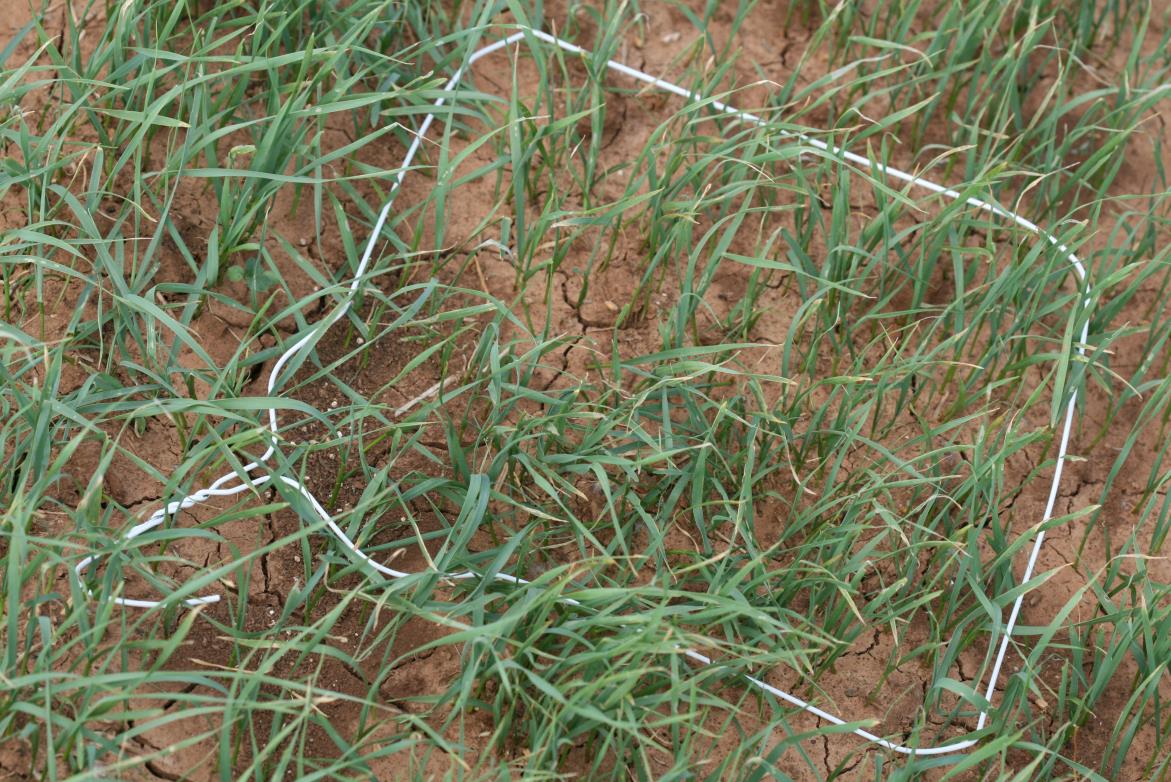Fall Armyworms May Become a Problem in Turf and Grass Pastures
About 10 days ago, a homeowner in Oklahoma City sent me a photo of an egg mass that was deposited on the side of his house. He also indicated that there were many other such egg masses strewn around his neighborhood.
In addition, I received another photo from David Nowlin of an egg mass attached to a peanut leaf.
In both cases, they were fall armyworm egg masses. In the past four days, I have received reports of fall armyworm infestations occurring in southeastern Oklahoma, southwestern Oklahoma, north central Oklahoma and the Oklahoma City area. They are infesting grass pastures, residential lawns, peanut fields, alfalfa, cotton, double cropped soybean and sorghum.
Fall armyworms are surface dwelling "climbing cutworm" caterpillars, so named because they tend to occur in noticeable numbers in late summer and fall, and they often “march” in large numbers from food source to food source.
Fall armyworms and their feeding activity often go unnoticed until they become 1 inch or more long. By then, they are large enough to destroy a grass pasture or a lawn overnight. They seem to prefer tall fescue, but they will also feed on bermudagrass and other turf. They do not overwinter in Oklahoma, but we will not be rid of them until we experience a true “killing frost”.
A little known fact: research has shown that the US actually has two “strains”, one called the corn strain and one called the rice strain. The corn strain originates from overwintering grounds in the Texas/Mexican Gulf coast. It prefers to feed on corn, sorghum and cotton. The rice strain originates from the Florida/ SE Gulf coastal areas. It prefers to feed on rice, alfalfa, pasture grasses (and lawns) and millet. The rice strain, which is likely the one we are experiencing now, occurs here sporadically (about every 4 or 5 years), while the corn strain is more of a regular pest.
Mature fall armyworms measure 1½ inches long when fully grown. Their body color can range from green, to brown to black.
Photo courtesy of Frank Peairs, Colorado State University and bugwood.org.
When looking for them, pay particular attention to their head capsule and the presence of a prominent inverted white "y" on the head capsule. A hand-held magnifying glass may be needed to see that feature on smaller larvae.
Small larvae do not eat through the leaf tissue, but instead, scrape off all of the green tissue and leave a clear membrane that gives the leaf a "window pane" appearance. Once they reach the forth instar, they can chew through the entire leaf. When scouting, look for both types of chewing damage.
The following are suggested thresholds for various crops in Oklahoma.
Grass pastures:
For those wanting to put up grass hay, scout your fields by looking for caterpillars
and “window paned” or chewed leaves. Get a wire coat hanger, bend it into a hoop,
place it on the ground, and count all sizes of caterpillars in the hoop. Take samples
in several locations, along the field margin as well as in the interior. The hoop
covers about 2/3 of a square foot.
Treatment threshold is an average of two or three ½ inch-long larvae per hoop sample (3-4 per square foot). They are easier to control with an insecticide when they are small (less than ½ inches). For control guidelines and specific insecticide information, consult OSU Fact Sheet CR-7193 Management of Insect Pests in Rangeland and Pasture.
Alfalfa
Regularly check you field using a sweep net. Also look for evidence of feeding (frass,
leaf feeding). Treatment threshold is an average of 2-3 per row foot.
OSU Fact Sheet CR-7150 Alfalfa Forage Insect Control
Cotton: Consult Cotton Comments Volume 11 Edition 11 for latest information on fall armyworm and other insect control suggestions.
Peanut:
The threat of yield reduction due to defoliation exists primarily when plants are
from 60 to 90 days old. Producers should check fields frequently during July and August
for the presence of earworms and armyworms and apply insecticides if populations exceed
3-5 larvae/row ft. in dryland or 6-8 larvae/row ft. in irrigated peanuts. Consult
E-832: Extension Agent’s Handbook of Insect, Plant Disease and Weed Control for specific
insecticide information.
Soybean:
For stand reduction, do not allow caterpillars to reduce stands by more than four
plants per row-foot. For larger soybean plants, base treatment thresholds by estimating
percent leaf loss as well as the presence of defoliators. Research from various states
has shown that soybeans can withstand 35% foliage loss up to one week before bloom.
During bloom and pod fill, the threshold falls to 15% to 20% defoliation, and then
increases to 35% to 40% defoliation once pods have filled. Consult CR-7167: Management of Insect and Mite Pests in Soybean or E-832: Extension Agent’s Handbook of Insect, Plant Disease and Weed Control for
specific insecticide information.
Turf and Lawns
Many insecticides are registered for control of fall armyworms that can provide excellent
control. For turf farms, golf courses and athletic fields, the pyrethroid insecticides,
which include Astro®, DeltaGard®, Demand®, Scimitar®, Talstar® or Tempo® are quite
effective. Conserve™, which is derived from a naturally-occurring bacterium, is also
an excellent product. Diazinon and Sevin® (carbaryl) are also labeled for some commercial
uses to control fall armyworms. Carefully read the label for use patterns, some products
may be registered for all turf uses, while others may not. Additional suggestions
are available in E-832: Extension Agent’s Handbook of Insect, Plant Disease and Weed
Control.
Fall armyworms can be detected through close examination of the lawn, or by using a “soap flush.” A soap flush simply involves mixing about 2 tablespoons of dishwashing soap into a gallon of water. Pour the soapy water over several small areas in your lawn and wait for 30 seconds to one minute. Any hidden larvae in the thatch will become irritated by the soap and come to the surface of the lawn. If 3-4 larvae are found per square foot, treatment may be warranted in commercial turf or golf courses.
For homeowners, carefully consider the need to control fall armyworms. Some cool-season lawns may be able to recover from a fall armyworm infestation this late in the year without treatment, and bermudagrass and zoysia lawns may be so slightly damaged that they would not warrant treatment. There are many products labeled for armyworm control in lawns and gardens. If choosing between granular and liquid applications, keep in mind that granular products are a bit slower acting, and require watering for activation. Carefully read and follow all label restrictions for application and use patterns. Specific control recommendations are found in EPP-7306 Ornamental and Lawn Pest Control (For Homeowners).







